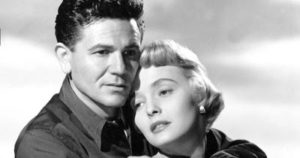STUDIO: Criterion | DIRECTOR: Michael Curtiz | CAST: John Garfield, Patricia Neal, Phyllis Thaxter, Juano Hernandez, Wallace Ford
RELEASE DATE: 8/8/17 | PRICE: DVD $18.28, Blu-ray $24.03
BONUSES: Interview about Curtiz with Alan K. Rode; Julie Garfield speaks about her father John; video essay by Taylor Ramos and Tony Zhou on the film’s visuals; Today Show segment on Hemingway’s house
SPECS: NR | 97 min. | Drama thriller | 1.37:1 widescreen | mono
One of the best remakes that appeared during the Golden Age of Hollywood, The Breaking Point is a more direct adaptation of Hemingway’s novel To Have and Have Not than the 1944 Hawks-Bogart-Bacall film of the same name. This 1950 thriller/character study not only does better justice to its source material, it also offers a terrific showcase for the talents of its star, the great John Garfield (The Postman Always Rings Twice).
The theatrically-trained Garfield was the link between the older tough guys (Bogart, Cagney, Robinson) and the Fifties generation of “rebel” actors (Clift, Brando, Dean). He had much in common with both groups and those qualities are certainly on display in Breaking Point. His fishing-boat captain character, Harry Morgan, is a no-nonsense veteran who repeatedly chooses his wife (Phyllis Thaxter) over the seductress (Patricia Neal, Breakfast at Tiffany’s) that pursues him throughout the picture.
While the Bogart version of the material was rewritten to mimic Casablanca, Breaking Point sticks with Hemingway’s original tale and focuses on the crisis of conscience affecting the broke Morgan, who has to decide whether to let criminals rent his boat or lose it entirely. The result is a thriller that isn’t noir in the strictest sense but does have noir overtones in terms of its plot and visuals.
The visuals are indeed as memorable as Garfield’s performance. Director Michael Curtiz (Casablanca), the man who tackled just about every genre imaginable, and cinematographer Ted McCord (The Treasure of the Sierra Madre) do a perfect job of reflecting Morgan’s conflicted state with mobile, impressively shadowy imagery.
Add to all this an entirely “normal” (read: not comic relief, or usual black stereotypes) African-American best friend character played by Juano Hernandez and a truly haunting final image related to him, and you have one of the great underrated masterworks of the post-war period.
The supplements supply a great deal of context for the film. The least important but still entertaining item is a 1962 segment from the Today Show, shot at Hemingway’s Key West home. Hemingway’s personal effects are shown, including the original manuscript of To Have and Have Not, with handwritten notations from “Papa” himself.
 Film historian Alan K. Rode explores Curtiz’s rich life in another supplement. Covering the Hungarian director’s career from its beginning in 1912 to The Breaking Point, Rode emphasizes that some of the lesser items that Curtiz directed were made because he was “addicted to making movies.” Rode notes that many actors loved Curtiz (who, at the peak of his activity, made up to six films a year), while others disliked him intensely — including Patricia Neal, who said she had a “ghastly” experience working with the director.
Film historian Alan K. Rode explores Curtiz’s rich life in another supplement. Covering the Hungarian director’s career from its beginning in 1912 to The Breaking Point, Rode emphasizes that some of the lesser items that Curtiz directed were made because he was “addicted to making movies.” Rode notes that many actors loved Curtiz (who, at the peak of his activity, made up to six films a year), while others disliked him intensely — including Patricia Neal, who said she had a “ghastly” experience working with the director.
The most interesting fact that Rode imparts is that the haunting final image of The Breaking Point wasn’t from the Hemingway novel or the script by Ranald MacDougall (Mildred Pierce). It was instead the brainchild of Curtiz, who thus devised the most unforgettable moment in the movie.
On the subject of who created what, Taylor Ramos and Tony Zhou note in a video essay on the film’s style that the many scenes of Harry Morgan’s homelife were created by MacDougall in the screenplay. Ramos and Zhou also present a strong argument for Curtiz as a visual stylist, showing how his images have both depth and movement, thus adding a strong emotional level to the film.
The most enlightening supplement is an interview with Julie Garfield, daughter of John, who is quite honest about her father’s virtues and faults. She sketches his early life and work as a stage actor, leading to his contract with Warner Brothers where he made several hits and more than a few misses.
She notes that, though both of her parents were left-wing, her father was more of a humanist, while her mother was a member of the Communist Party. This came up later when John’s name appeared in “Red Channels,” the publication that in part dictated which people in show business were to be blacklisted.
Julie discusses how John turned his film career around by starting Enterprise Productions and making his biggest hit, Body and Soul (1947). After that the rumors about his being “a Red” started circulating. The Breaking Point was his penultimate film and the last one made before he was fully blacklisted.
John refused to sign a document that admitted his wife was a Communist and so he was, according to Julie, followed by FBI agents and had his phone tapped. She discusses how Breaking Point was dropped like a hot potato by Warner Bros. and has since gotten the acclaim it deserved back when it was first released.
Adding to the chorus of praise for the film was “Papa” himself. Julie notes that Patricia Neal spoke with Hemingway, who told her that Breaking Point was the only film made from one of his works that he liked.
|
Buy or Rent The Breaking Point
|
|---|
Leave a Reply